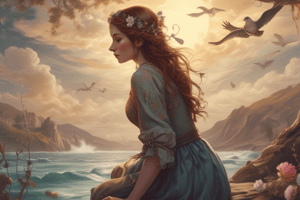Podcast
Questions and Answers
Romanticism was a literary movement that occurred in English literature during the 15th and 16th centuries.
Romanticism was a literary movement that occurred in English literature during the 15th and 16th centuries.
False (B)
The Romantic Age saw a shift towards a more objective approach to art and literature.
The Romantic Age saw a shift towards a more objective approach to art and literature.
False (B)
Romantic poets often used irony to support social and political structures.
Romantic poets often used irony to support social and political structures.
False (B)
Romanticism valued individualism and explored the shared experiences of groups.
Romanticism valued individualism and explored the shared experiences of groups.
Nature played a significant role in the Romantic Age, with poets often drawing inspiration from the urban world.
Nature played a significant role in the Romantic Age, with poets often drawing inspiration from the urban world.
William Wordsworth and John Keats were poets who often wrote about the power of nature.
William Wordsworth and John Keats were poets who often wrote about the power of nature.
William Wordsworth was known for his focus on spiritual experiences and the journey of the soul.
William Wordsworth was known for his focus on spiritual experiences and the journey of the soul.
The Romantic period saw a shift towards using Latin in poetry.
The Romantic period saw a shift towards using Latin in poetry.
John Keats was a prominent figure in the Romantic Age, known for his focus on nature and the human experience.
John Keats was a prominent figure in the Romantic Age, known for his focus on nature and the human experience.
The influence of Romantic poets can still be seen in modern literature and culture.
The influence of Romantic poets can still be seen in modern literature and culture.
William Blake wrote in a style that was closer to everyday speech.
William Blake wrote in a style that was closer to everyday speech.
The Romantic Age saw a decline in the popularity of poetry among the lower classes.
The Romantic Age saw a decline in the popularity of poetry among the lower classes.
Flashcards
Romanticism
Romanticism
A literary movement in the late 18th and early 19th centuries, rebelling against rules and conventions, emphasizing nature, imagination, and individualism.
Valuing Nature
Valuing Nature
A key aspect of Romanticism where the beauty and power of the natural world served as a major source of inspiration.
Emphasizing Imagination
Emphasizing Imagination
A valued aspect of Romanticism that acted as a means to transcend societal constraints and explore the depths of the human mind.
Individualism
Individualism
Signup and view all the flashcards
Vernacular Accessibility
Vernacular Accessibility
Signup and view all the flashcards
William Wordsworth
William Wordsworth
Signup and view all the flashcards
John Keats
John Keats
Signup and view all the flashcards
William Blake
William Blake
Signup and view all the flashcards
Study Notes
English Literature: Romanticism
Romanticism was a literary movement that occurred in English literature during the late 18th and early 19th centuries. It was a rebellion against the rules and conventions of the time, focusing on values such as nature, imagination, and individualism. This time period, often referred to as the Romantic Age, saw a shift towards a more emotional and subjective approach to art and literature.
Key Features of Romanticism
Valuing Nature
Nature played a significant role in the Romantic Age, with poets often drawing inspiration from the natural world. This can be seen in the works of poets such as William Wordsworth and John Keats, who often wrote about the beauty and power of nature. One example is Wordsworth's poem "Holy Thursday: Is this a holy thing to see," which explores the contrast between the richness of the land and the misery of the children within it.
Emphasizing Imagination
Another defining characteristic of Romantic poetry was the emphasis on imagination. This was seen as a way to escape the constraints of society and explore the inner workings of the human mind. Romantic poets often used irony, or a contrast between expectation and reality, to challenge social and political structures.
Individualism
Romanticism also valued individualism, with poets often exploring the unique experiences and emotions of individuals. This can be seen in the works of poets such as William Blake, who wrote about personal spiritual experiences and the journey of the soul.
Language and Accessibility
During the Romantic period, there was a shift towards using the common vernacular in poetry. This made poetry more accessible to a wider audience, including the lower classes. This can be seen in the works of poets such as Wordsworth, who wrote in a style that was closer to everyday speech.
Influential Poets of the Romantic Era
William Wordsworth
William Wordsworth was a prominent figure in the Romantic Age, known for his focus on nature and the human experience. Some of his most famous works include "I Wandered Lonely as a Cloud" and "Tintern Abbey."
John Keats
John Keats was an influential Romantic poet known for his exploration of beauty, love, and the human experience. Some of his most famous works include "Ode to a Nightingale" and "Ode on a Grecian Urn."
William Blake
William Blake was a unique voice in the Romantic movement, focusing on spiritual experiences and the journey of the soul. Some of his most famous works include "The Tyger" and "And Did Those Feet in Ancient Time."
Despite the end of the Romantic Age, the influence of these poets and the values they represented continue to be felt in modern literature and culture.
Studying That Suits You
Use AI to generate personalized quizzes and flashcards to suit your learning preferences.




